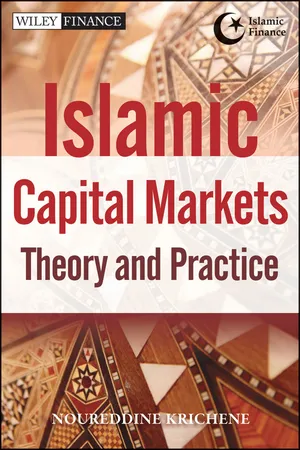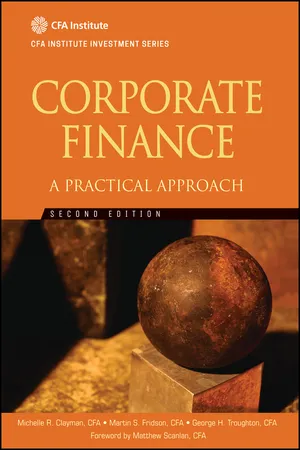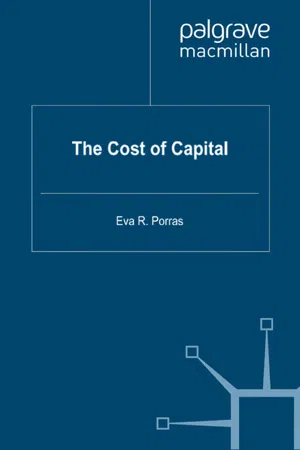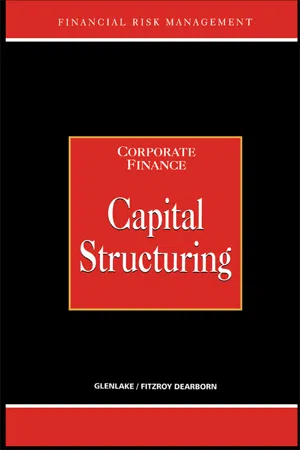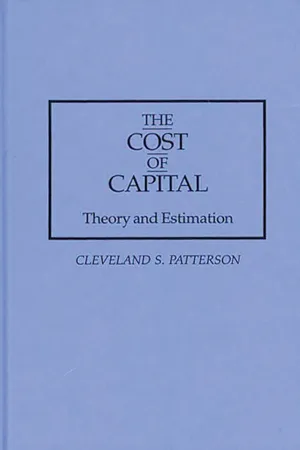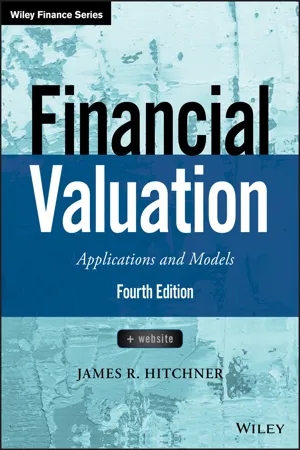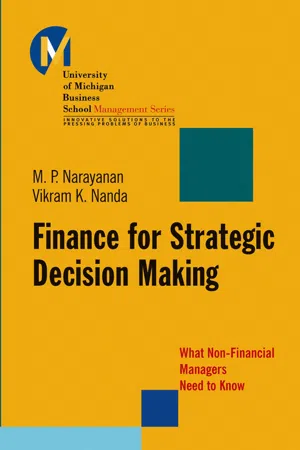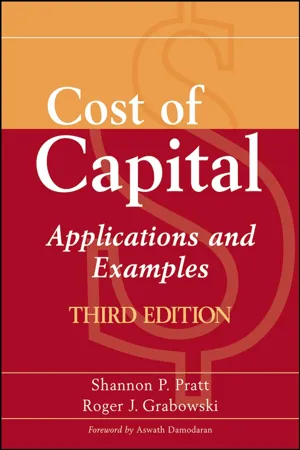Business
Cost of Capital
Cost of capital refers to the expense a company incurs to finance its operations through equity and debt. It represents the return that investors expect to receive for providing capital to the company. Calculating the cost of capital helps businesses make decisions about investments and financing, as it provides a benchmark for evaluating the potential returns of various projects.
Written by Perlego with AI-assistance
Related key terms
1 of 5
12 Key excerpts on "Cost of Capital"
- eBook - ePub
Islamic Capital Markets
Theory and Practice
- Noureddine Krichene(Author)
- 2012(Publication Date)
- Wiley(Publisher)
market refers to the universe of investors who are reasonable candidates to provide funds for a particular investment. Capital or funds are usually provided in the form of cash, although in some instances capital may be provided in form of other assets. The Cost of Capital usually is expressed in percentage terms—that is, the annual amount of dollars that investors require or expect to realize, expressed as a percentage of the dollar amount invested. It applies to a company, security, or project in which we are interested.Since the cost of anything can be defined as the price one must pay to get it, the Cost of Capital is the return a company must promise in order to get capital from the market, either debt or equity. A company does not set its own Cost of Capital; it must go to the market to discover it. Yet meeting this cost is the financial market’s one basic yardstick for determining whether a company’s performance is adequate. The Cost of Capital is always an expected or forward-looking return. The opportunity Cost of Capital is equal to the return that could have been earned on alternative investments at a specific level of risk. In other words, it is the competitive return available in the market on a comparable investment, with risk being the most important component of comparability.The Cost of Capital depends on the components of a company’s capital structure. The primary components of a capital structure include:- Debt capital
- Preferred equity
- Common equity
Each component of an entity’s capital structure has its unique cost, depending primarily on its respective risk. The Cost of Capital can be viewed from three different perspectives. On the asset side of a firm’s balance sheet, it is the rate that should be used to discount to a present value the future expected cash flows. On the liability side, it is the economic cost to the firm of attracting and retaining capital in a competitive environment, in which investors (capital providers) carefully analyze and compare all return-generating opportunities. On the investor’s side, it is the return one expects and requires from an investment in a firm’s debt or equity. While each of these perspectives might view the Cost of Capital differently, they are all dealing with the same number. - eBook - ePub
Corporate Finance
A Practical Approach
- Michelle R. Clayman, Martin S. Fridson, George H. Troughton(Authors)
- 2012(Publication Date)
- Wiley(Publisher)
Cost of Capital estimation is a challenging task. As we have already implied, the Cost of Capital is not observable but, rather, must be estimated. Arriving at a Cost of Capital estimate requires a host of assumptions and estimates. Another challenge is that the Cost of Capital that is appropriately applied to a specific investment depends on the characteristics of that investment: The riskier the investment’s cash flows, the greater its Cost of Capital. In reality, a company must estimate project-specific costs of capital. What is often done, however, is to estimate the Cost of Capital for the company as a whole and then adjust this overall corporate Cost of Capital upward or downward to reflect the risk of the contemplated project relative to the company’s average project.This chapter is organized as follows: In the next section, we introduce the Cost of Capital and its basic computation. Section 3 presents a selection of methods for estimating the costs of the various sources of capital, and Section 4 discusses issues an analyst faces in using the Cost of Capital. Section 5 summarizes the chapter.2. Cost of CapitalThe Cost of Capital is the rate of return that the suppliers of capital—bondholders and owners—require as compensation for their contribution of capital. Another way of looking at the Cost of Capital is that it is the opportunity cost of funds for the suppliers of capital: A potential supplier of capital will not voluntarily invest in a company unless its return meets or exceeds what the supplier could earn elsewhere in an investment of comparable risk.A company typically has several alternatives for raising capital, including issuing equity, debt, and instruments that share characteristics of debt and equity. Each source selected becomes a component of the company’s funding and has a cost (required rate of return) that may be called a component Cost of Capital. Because we are using the Cost of Capital in the evaluation of investment opportunities, we are dealing with a marginal - eBook - PDF
- E. Porras(Author)
- 2010(Publication Date)
- Palgrave Macmillan(Publisher)
6 1 A General Introduction to Risk, Return, and the Cost of Capital The relevance of the Cost of Capital The Cost of Capital to a firm is the return 1 investors receive on their investments. Therefore, in this context, an investor is anyone who lends money to a firm or agency in exchange for some ‘profit’. The providing of funds to the firm could be done by purchasing some of the company’s common stock, bonds, 2 or in a number of additional ways we shall comment on later. The higher the profit desired by the investor, the greater the cost to the firm or paying agency. One reason why firms calculate their Cost of Capital is to determine a mini- mum discount rate 3 to use when evaluating proposed capital expenditure projects. The purpose of capital expenditure analysis is to decide which, if any, of a list of planned projects, the firm should actually undertake. It is then logical that the Cost of Capital to be estimated and compared with the expected benefits from the proposed projects is equated with the marginal Cost of Capital the firm raises (the price of acquiring the next dollar, pound, yen or euro ...), not a historical-cost estimate. This is because firms must incorporate the real costs into their calculations when capital is going to be raised, and past histori- cal information is of no use for this purpose. If the marginal Cost of Capital is too high, the firm might find out none of its list of proposed projects is capable of returning sufficient profit to cover that cost. For example, let us say you want to open a photocopying business. This project is going to be financed exclusively with equity 4 and, considering the return that could be made on equivalent investments, your shareholders want a 35 per cent return. If all you can expect to make with this project is 10 per cent on each dollar invested, you could not afford to repay what your investors demand. - eBook - ePub
- Alastair Graham(Author)
- 2004(Publication Date)
- Routledge(Publisher)
3Funding Options
The choice between equity, debt and hybrid financial instruments is influenced by a variety of factors:In the previous chapter, it was suggested that management should make an estimate of the total external funding requirements over the business planning period, and categorize them into long-term, shorter-term and contingency funds. The next stage in the planning process is to decide, in broad terms, how much of the new funds should be raised in the form of equity, how much as debt, and whether hybrid financial instruments should be used for part of the funding.- the cost of each funding option (particularly the cost of equity and the cost of debt capital)
- stock market rating
- operational profits and cash flows
- leverage (financial leverage)
- the purpose for which the funds are required (nature and duration of the funded activities)
- availability
- recent funding measures
- control of the company
- individual preferences.
Cost of Capital
The Cost of Capital is the average return, over the long term, that investors expect to receive from their investment. It is therefore the average yield that companies should expect to pay. There is the cost of equity stocks, and a cost for each issue of debt capital and each bank loan. Each financial instrument has a different cost to the issuer, and the Cost of Capital can vary over time, as investor expectations change.To a company, the overall cost of its funds (debt, equity and hybrid instruments together) is the return its investors expect to receive in the long term, expressed as a percentage annual rate of return. This average cost of funds is commonly referred to as the company’s weighted average Cost of Capital. A company’s aim should be, if possible, to minimize its average cost of funds, and raise capital at the cheapest rate possible. - eBook - PDF
The Cost of Capital
Theory and Estimation
- Cleveland S. Patterson(Author)
- 1995(Publication Date)
- Praeger(Publisher)
.-1 The Concept and Uses of the Cost of Capital This chapter introduces the concept of the opportunity Cost of Capital and re- views its use for corporate and public policy decisions. It also briefly discusses some of the difficulties involved in the estimation of its magnitude for an indi- vidual asset or firm. I. THE CONCEPT OF THE Cost of Capital Most productive enterprises require a mixture of inputs to make them viable. Some of these inputs, such as labor, have clearly identifiable out-of-pocket annual costs associated with them in the form of wages, salaries, benefits, or directly assignable overheads. Others, however, take the form of capital inputs or investments. Essentially investments represent decisions to defer present consumption until a later date, and their "cost" is largely an opportunity cost rather than an out-of-pocket cash cost. We define the opportunity cost of a particular investment, A, as the expected return on the best comparable alternative, B, which is foregone as a result of the decision to commit capital to A. Although costs are normally thought of as dollars paid out, dollars not received have exactly the same effect on the ability to purchase goods. For example, assume that a firm decides to invest $100,000 in a productive asset, which promises, with certainty, to yield a payoff in constant dollars of 2 The Cost of Capital $120,000 at the end of one year. Investors usually require an inducement to defer consumption and the specific rate of return that they require for a riskless one-year investment is established by supply and demand conditions in capital markets. Let us say that it is possible to obtain a guaranteed annual return of 10% by investing in traded market securities such as one-year discount govern- ment bonds. Then the opportunity cost of investing in the project is 10%. If there are no transactions costs or taxes, this is also the project's Cost of Capital. - eBook - ePub
The Value Sphere
The Corporate Executives' Handbook for Creating and Retaining Shareholder Wealth
- John Boquist, Todd Milbourn, Anjan Thakor(Authors)
- 2009(Publication Date)
- WSPC(Publisher)
Jerry's discussions with Bob about the Cost of Capital had provided Jerry with his toughest mental challenge to date. However, while he could not claim to be an expert on all the details, he at least has an intuitive grasp of the key ideas. These were that his company's Cost of Capital was related in a systematic way with how cyclical the company's returns were relative to the whole stock market and how much debt it had on its balance sheet. That would do nicely for a start.Main Points• The Cost of Capital is a critical input to resource allocation decisions. It specifies the minimum return required by the capital markets on our investments and is an essential component of the internal performance metrics that are a part of a company's Value Sphere. It establishes the capital market bench mark to gauge company's financial performance.• The cost of debt capital is tax-advantaged because interest expense is tax deductible. The after-tax cost of debt is the one that should be used in computing our overall WACC.• The cost of equity capital can be determined with the Capital Asset Pricing Model (CAPM). The cost of equity is not tax advantaged and is determined by adding to the risk-free return on government bonds to a risk adjustment that equals our equity “beta” times a risk premium for the whole market.• Our beta measures how volatile our stock's return is relative to that of the whole US stock market.• The WACC, is determined by weighting the after-tax cost of debt and the cost of equity by the proportions of each in the firm's capital structure. The proportions are given by market value weights for the existing capital structure or the target structure of the firm. - No longer available |Learn more
Financial Valuation
Applications and Models
- James R. Hitchner(Author)
- 2017(Publication Date)
- Wiley(Publisher)
Often a business enterprise—particularly in the small and midsize markets—is focused on the benefit stream and growth potential variables, while too often the risk is left to chance. Assuming no change in the first two variables, reducing the risk attributes of a business will increase its value. 186 FINANCIAL VALUATION The Cost of Capital is also referred to as the discount rate. It equals the total expected rate of return for the investment—that is, dividends or withdrawals, plus expected capital appreciation over the life of the investment. This rate can be applied to the appropriate income or cash flow stream of a company to estimate the company’s present value. ValTip Identifying the value drivers of an enterprise and developing action steps to limit or reduce controllable (e.g., internally oriented versus external) risks can be of great benefit to many closely held businesses in terms of increasing their value. The value of a company can be expressed as the present value of the future economic benefits expected to be generated by the company. This value can be either for equity, in which case the future benefits are those directly to equity and an equity discount rate must be used, or for the overall company, including its debt, in which case a weighted average Cost of Capital (WACC) must be used. ValTip The Cost of Capital reflects investors’ return expectations, which are essentially composed of a risk-free rate and a risk premium: 1 ■ The risk-free rate captures a rental rate, inflation, and maturity risk. The rental rate represents a real return for lending funds free of default risk and forgoing current consumption. Inflation and inflation risk represent expected inflation and the risk that expected inflation will increase. Maturity risk represents the risk that the investment’s principal market value will change during the period to maturity as a function of changes in interest rates. - eBook - ePub
Corporate Valuation
Measuring the Value of Companies in Turbulent Times
- Mario Massari, Gianfranco Gianfrate, Laura Zanetti(Authors)
- 2016(Publication Date)
- Wiley(Publisher)
Chapter 8 Estimating the Cost of Capital8.1 DEFINING THE OPPORTUNITY Cost of Capital
In the previous Chapters we have discussed the calculation of the proper discount rate for cash flows by introducing formulas that are consistent with the asset and equity side standpoints and with the different definitions and derivations of the tax benefits associated with debt. All these formulas stem from two basic parameters referred to as the opportunity Cost of Capital of a firm with no debt ( ) and the opportunity cost of debt ( ).measures the rate of return that is considered acceptable by investors in the equity of a firm with no debt. The return should reflect only the risk profile associated with corporate assets regardless of the financial structure. As we are dealing with an opportunity cost, this return should be estimated taking into account the alternative returns that could be obtained from other investments characterized by similar risk profiles.On the other hand, measures (again, as an opportunity cost) the rate of return that is deemed acceptable by the holders of the firm debt. The risk for the underwriters of corporate financial liabilities is mostly a function of the likelihood of the firm not being able to timely fulfill its obligations along the agreed debt service schedule.8.2 A FEW COMMENTS ON RISK
For economists, risky situations are usually associated with cases in which an “objective” probability (i.e., based on meaningful retrospective observations) can be attributed to a range of possible events. “Uncertain” situations, on the other hand, are characterized by the apparent inability to attribute an objective probability to a certain event.Following the general practice, going forward we will use the terms risk and uncertainty - eBook - PDF
Finance for Strategic Decision-Making
What Non-Financial Managers Need to Know
- M. P. Narayanan, Vikram K. Nanda(Authors)
- 2004(Publication Date)
- Jossey-Bass(Publisher)
55 3 Cost of Capital C hapter Two presents the basics of NPV and IRR, two methods for resource allocation decisions. To implement either method, we need the Cost of Capital of the specific resource allocation decision (that is, the project under consider-ation). This chapter follows up by explaining how Cost of Capital can be determined for use in those methods. In discussing the Cost of Capital, we also address another related issue still pend-ing from Chapter Two, namely, the estimation of risk. Let’s begin once again with a case. Suppose that, as head of strategic planning and business development for a conglomerate with interests in a wide range of consumer and industrial businesses, you are responsible for 56 Finance for Strategic Decision Making making recommendations to the CEO about all strategic capi-tal investments. These decisions include proposing acquisitions and major capital expenditures of the various divisions in line with the firm’s strategy. The proposal that you are currently evaluating concerns the purchase of a factory manufacturing basic chemicals from another company. As you evaluate the fi-nancial analysis, you notice that the Cost of Capital used to value the factory is different from your conglomerate’s Cost of Capital and from that of the chemical division of your conglomerate. While you are able to critically evaluate the estimation of cash flows provided to you by your team, given your prior experi-ence in manufacturing and marketing, you are unsure about how Cost of Capital is estimated. You recognize the need to un-derstand how the Cost of Capital is determined to make effective resource allocation recommendations to the CEO. ■ WACC: A General Approach to Estimating Cost of Capital Since the Cost of Capital of a project is determined by what in-vestors expect to earn elsewhere at the same risk as the project, the Cost of Capital depends in part on the risk of the project. - eBook - PDF
Corporate Finance
Economic Foundations and Financial Modeling
- Michelle R. Clayman, Martin S. Fridson, George H. Troughton, Michelle R. Clayman, Martin S. Fridson, George H. Troughton(Authors)
- 2022(Publication Date)
- Wiley(Publisher)
CHAPTER 8 Cost of Capital: ADVANCED TOPICS Lee M. Dunham, PhD, CFA Creighton University (USA) Pamela Peterson Drake, PhD, CFA James Madison University (USA) LEARNING OUTCOMES The candidate should be able to: • explain top-down and bottom-up factors that impact the Cost of Capital • compare methods used to estimate the cost of debt • explain historical and forward-looking approaches to estimating an equity risk premium • compare methods used to estimate the required return on equity • estimate the cost of debt or required return on equity for a public company and a private company • evaluate a company’s capital structure and Cost of Capital relative to peers 1. INTRODUCTION A company’s weighted average Cost of Capital (WACC) represents the cost of debt and equity capital used by the company to finance its assets. The cost of debt is the after-tax cost to the issuer of debt, based on the return that debt investors require to finance a company. The cost of equity represents the return that equity investors require to own a company, also referred to as the required rate of return on equity or the required return on equity. A company’s WACC is used by the company’s internal decision makers to evaluate capital investments. For analysts and investors, it is a critical input used in company valuation. Equation 1 reminds us that a company’s WACC is driven by the proportions, or weights (the w i Þ, of the different capital sources used in its capital structure, applied to the costs of 249 each source (the r i ), with d, p, and e subscripts denoting debt, preferred equity, and common equity, respectively: WACC ¼ w d r d (1 – t) þ w p r p þ w e r e . (1) (These weights are all non-negative and sum to 1.0.) Determining a company’s WACC is an important, albeit challenging, task for an analyst given the following: • Many different methods can be used to calculate the costs of each source of capital; there is no single, “right” method. - eBook - PDF
- Shannon P. Pratt, Roger J. Grabowski(Authors)
- 2008(Publication Date)
- Wiley(Publisher)
If guideline public companies are not available, you can turn to a fundamental analysis of the risks and the returns of the specific functions. In either case, you need to reconcile the resulting Cost of Capital estimates to the overall Cost of Capital of the business enterprise. 6 Nestle Holdings, Inc. v. Commissioner, T.C. Memo. 1995-441, affd. in part, revd. and remanded in part 152 F.3d 83 (2d Cir. 1998); T.C. Memo.2000-374. 408 Cost of Capital Chapter 24 Central Role of Cost of Capital in Economic Value Added Joel M. Stern, G. Bennett Stewart, III, and Donald H. Chew, Jr. Introduction EVA Financial Management System EVA and the Corporate Reward System EVA Bonus Plan: Simulating Ownership Leveraged Stock Options: Making Ownership Real Summary INTRODUCTION As was discussed in the preface to this book, one of the four traits of great chief executives is their understanding of the fundamental reality of wealth creation. Successful organizations invest to earn a rate of return in excess of their Cost of Capital. These executives pass that understanding onto their organization and its business managers. An economic value added (EVA)–based performance meas- urement system makes the Cost of Capital explicit. In its simplest form, EVA is net operating profit after taxes less a charge for the capital employed to produce those profits. The capital charge is the required, or minimum, rate of return necessary to compensate all the firm’s investors, debt holders, and shareholders for the risk of the investment. EVA is charged for capital at a rate that compensates investors for bearing the firm’s explicit busi- ness risk. The assessment of business risk is based on the Capital Asset Pricing Model (CAPM), which allows for a specific, market-based evaluation of risk for a company and its individual business units using the concept of beta. - eBook - PDF
- Robert Parrino, David S. Kidwell, Thomas Bates, Stuart L. Gillan(Authors)
- 2021(Publication Date)
- Wiley(Publisher)
How do taxes affect the cost of debt? LEARNING OBJECTIVE 3. Calculate the cost of common stock and the cost of preferred stock for a firm. The cost of equity (stock) for a firm is a weighted average of the costs of the different types of stock that the firm has outstanding at a particular point in time. We saw in Chapter 9 that some firms have both preferred stock and common stock outstanding. In order to calculate the cost of equity for these firms, we have to know how to calculate the cost of both common stock and preferred stock. In this section, we discuss how financial analysts can estimate the costs associated with these two different types of stock. Common Stock Just as information about market rates of return is used to estimate the cost of debt, market information is also used to estimate the cost of equity. There are several ways to do this. The particular approach a financial analyst chooses will depend on what information is available and how reliable the analyst believes it is. In this section we discuss three alternative methods for estimating the cost of common equity (stock). It is important to remember throughout this discussion that the “cost” we are referring to is the rate of return that investors require for investing in the stock at a particular point in time, given its systematic risk. Method 1: Using the Capital Asset Pricing Model (CAPM) The first method for estimating the cost of common equity is one that we discussed in Chapter 7. This method uses Equation 7.12: E(R i ) = R rf + β i [E(R m ) − R rf ] In this equation, the expected return on an asset is a linear function of the systematic risk associated with that asset as measured by beta.
Index pages curate the most relevant extracts from our library of academic textbooks. They’ve been created using an in-house natural language model (NLM), each adding context and meaning to key research topics.
